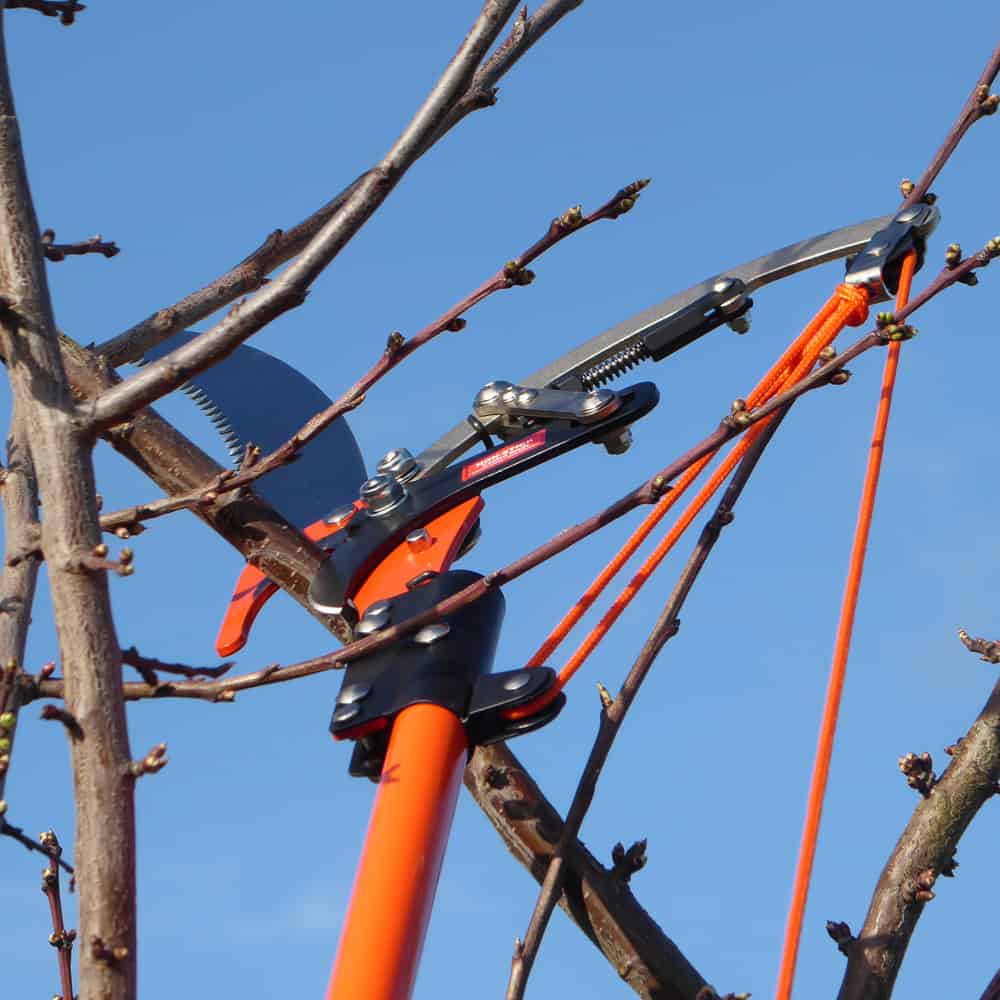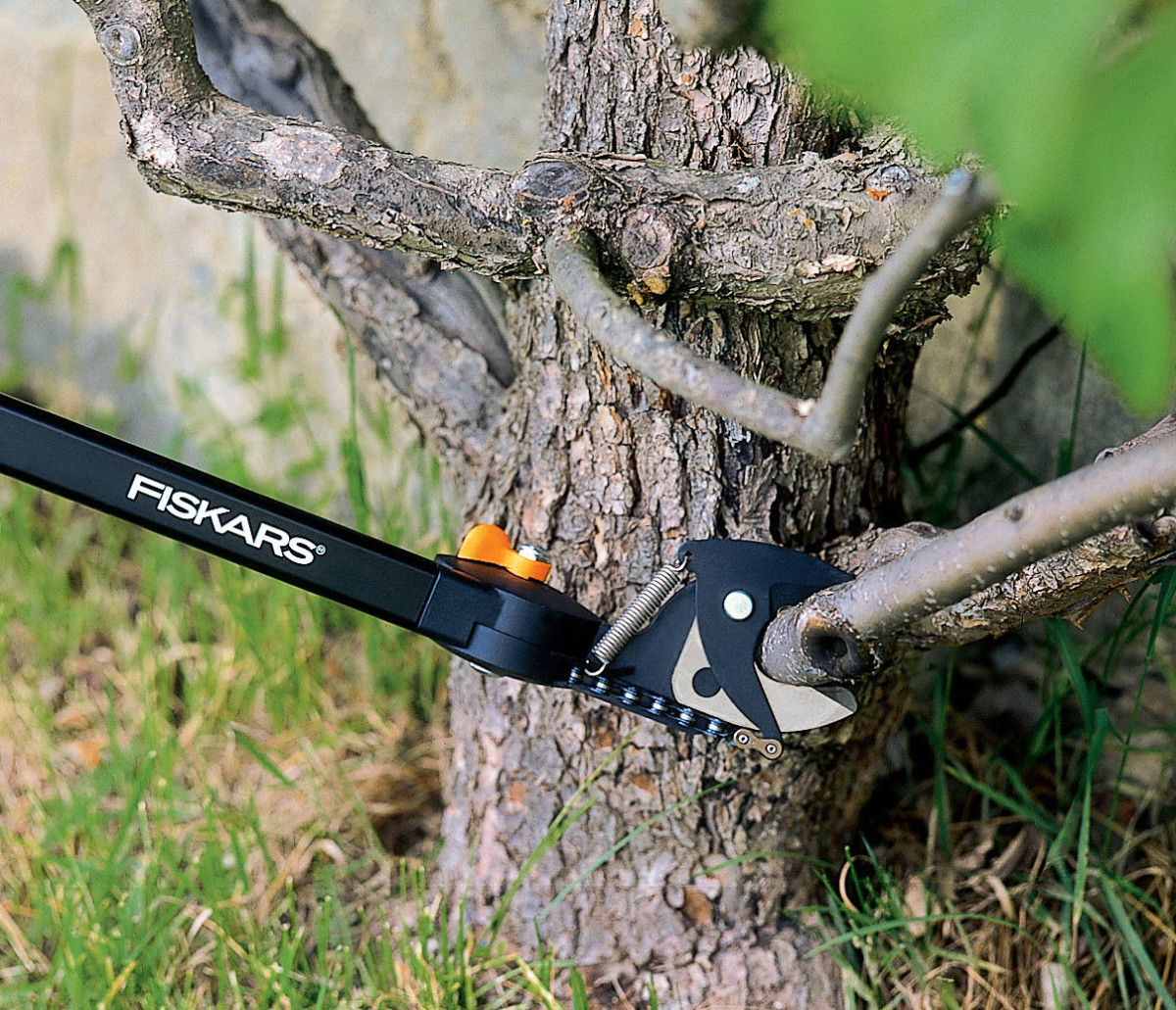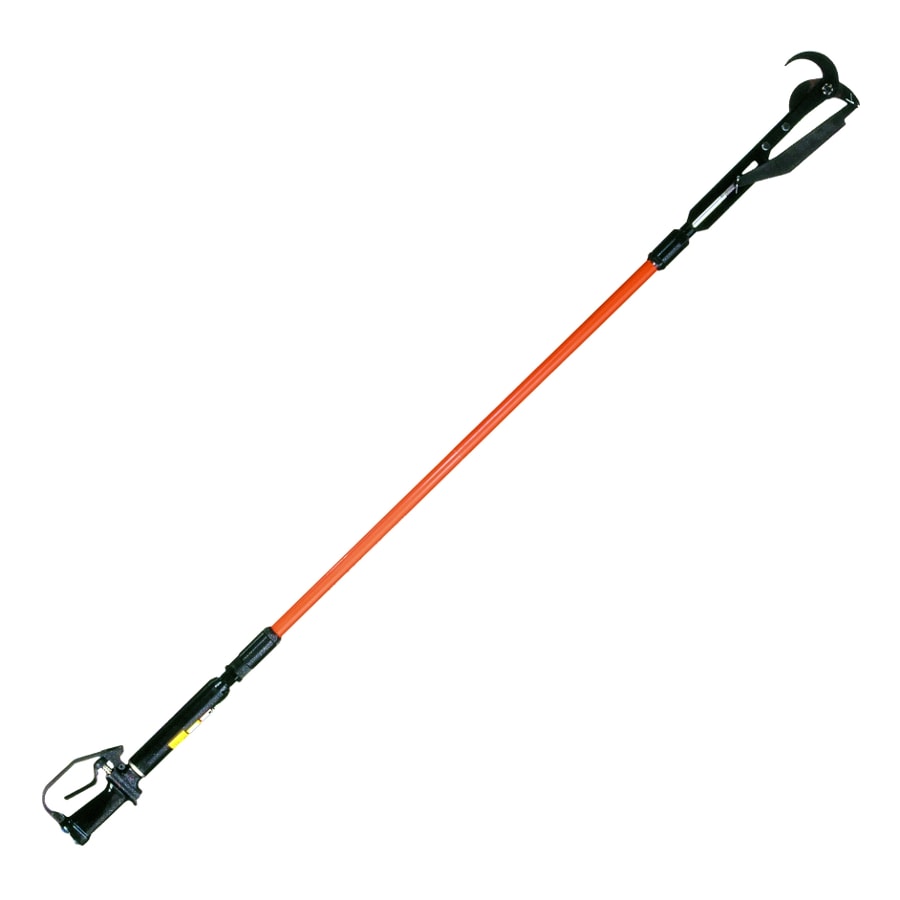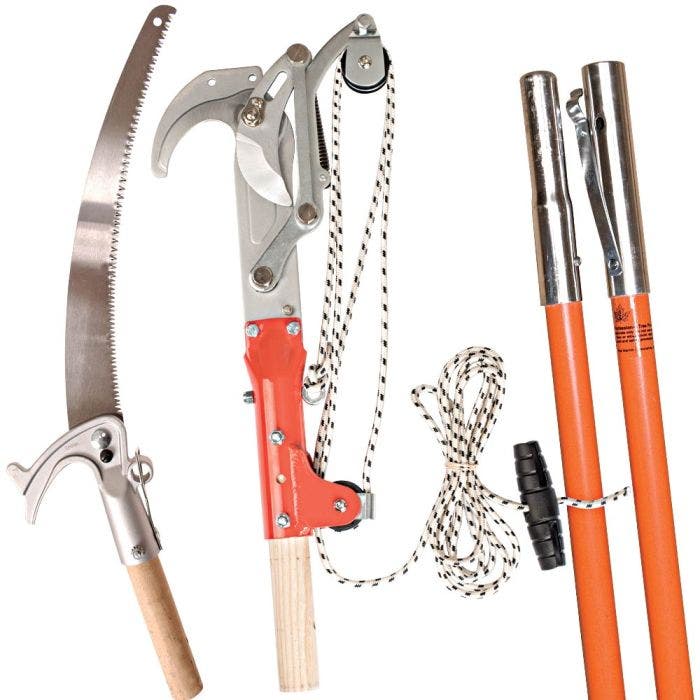Gardening is an art, a science, and a passion for many. Whether you’re tending to a small backyard oasis or a sprawling estate, the right tools make all the difference. One such essential tool for any gardener is the pole pruner. But what exactly are pole pruners, and why should they be a staple in your gardening toolkit? Let’s dive in.
Understanding Pole Pruners
Definition and Purpose
Pole pruners are long-handled pruning tools designed to reach high branches and dense foliage that are out of reach of standard hand pruners. They allow gardeners to prune without the need for ladders, providing both safety and convenience.
| Aspect | Description |
|---|---|
| Definition | Long-handled pruners for high branches |
| Purpose | Safe pruning of tall trees and dense foliage |
| Primary Users | Home gardeners, professional landscapers, orchard managers |
| Key Benefits | Eliminates ladder use, enhances safety, extends reach |
| Typical Length | Ranges from 6 to 18 feet, often with telescopic capabilities |
Types of Pole Pruners
Pole pruners come in two main varieties: manual and powered. Each type has its unique features, benefits, and limitations.
Manual Pole Pruners
Manual pole pruners are operated by hand, using a rope-and-pulley system or a lever mechanism. They are lightweight, require no fuel or electricity, and are relatively quiet.
| Feature | Manual Pole Pruners |
|---|---|
| Power Source | Human effort |
| Weight | Generally lighter |
| Noise Level | Silent operation |
| Maintenance | Low, mainly cleaning and occasional sharpening |
| Cost | More affordable |
Powered Pole Pruners
Powered pole pruners are either electric, battery-operated, or gas-powered. They offer more power, making them suitable for cutting thicker branches with less effort.
| Feature | Powered Pole Pruners |
|---|---|
| Power Source | Electric, battery, or gas |
| Weight | Heavier due to motors and batteries |
| Noise Level | Can be noisy, especially gas-powered models |
| Maintenance | Requires regular maintenance of motor and parts |
| Cost | More expensive |

Source Image: www.stihlusa.com
Advantages and Limitations
Each type of pole pruner comes with its own set of pros and cons. Understanding these can help you choose the right one for your needs.
| Criteria | Advantages of Manual | Advantages of Powered | Limitations of Manual | Limitations of Powered |
|---|---|---|---|---|
| Ease of Use | Simple, no technical skills needed | Cuts thicker branches easily | Requires physical effort | Heavier and can be cumbersome |
| Maintenance | Minimal | Efficient for large tasks | Limited cutting power | Requires regular maintenance |
| Noise and Emissions | Quiet, no emissions | Time-saving | Slower for large tasks | Noise and potential emissions |
| Cost | Budget-friendly | Suitable for professional use | Can be time-consuming | Higher initial investment |
Choosing the Right Pole Pruner
Selecting the best pole pruner depends on various factors, from garden size to the types of plants you need to trim.
Factors to Consider
When choosing a pole pruner, it’s essential to consider your garden’s specific needs and your own preferences.
| Factor | Considerations |
|---|---|
| Garden Size and Layout | Larger gardens may benefit from powered pruners for efficiency |
| Type of Plants | Thicker branches may require powered pruners |
| Personal Physical Ability | Manual pruners may be tiring for some; powered options offer ease |
| Budget | Manual pruners are cost-effective; powered pruners are an investment |
Garden Size and Layout
The size and layout of your garden significantly influence your choice. Larger gardens with many trees and shrubs might necessitate the use of powered pruners to save time and effort.
| Garden Type | Recommended Pruner Type |
|---|---|
| Small to Medium Gardens | Manual pole pruners |
| Large Gardens | Powered pole pruners |
| Dense Foliage Areas | Powered pole pruners for efficiency |
Type of Plants Being Pruned
Different plants have different pruning needs. Knowing your plants helps in selecting the most effective tool.
| Plant Type | Suitable Pruner Type |
|---|---|
| Young Trees and Shrubs | Manual pole pruners |
| Mature Trees | Powered pole pruners |
| Thick Branches | Powered pole pruners |
| Delicate Plants | Manual pole pruners for precision |
Personal Preference and Physical Ability
Your comfort and ability to handle the tool are crucial. If you find manual pruners tiring, a powered pruner might be more suitable.
| Personal Factor | Recommended Action |
|---|---|
| Physical Strength | Consider powered pruners |
| Experience Level | Beginners might prefer manual for control |
| Frequency of Use | Regular use may justify powered investment |

Source Image: dengarden.com
Components of Pole Pruners
Understanding the anatomy of a pole pruner can help you make an informed decision.
Anatomy of a Pole Pruner
A pole pruner consists of several key components, each playing a crucial role in its functionality.
| Component | Description |
|---|---|
| Pole | The extendable arm, often telescopic |
| Cutting Head | The blade and mechanism for cutting |
| Blade Types | Bypass, anvil, ratchet |
| Mechanisms | Rope-and-pulley, lever, motorized |
Pole Length and Material
The length and material of the pole affect its reach and durability.
| Aspect | Options |
|---|---|
| Length | Typically 6 to 18 feet, telescopic versions |
| Material | Aluminum, fiberglass, wood |
Cutting Head and Blade Types
The cutting head is where the actual pruning happens. Different blade types serve different purposes.
| Blade Type | Best For |
|---|---|
| Bypass | Precise cuts on live wood |
| Anvil | Cutting through dry, dead wood |
| Ratchet | Extra leverage for thick branches |
Pruner Mechanisms
The mechanism determines how the cutting action is performed.
| Mechanism | Description |
|---|---|
| Rope-and-Pulley | Uses a rope to activate the cutting blade |
| Lever | Uses a lever action for cutting |
| Motorized | Powered by electric or gas motor for efficiency |
Safety Precautions for Pole Pruning
Safety should always be a top priority when using pole pruners.
Ensuring Safe Operation
Before you start pruning, make sure to take necessary precautions to ensure your safety.
| Safety Measure | Description |
|---|---|
| Protective Gear | Gloves, eyewear, hard hat if necessary |
| Equipment Check | Inspect for any damage or wear |
| Positioning | Stable footing, clear work area |
Protective Gear
Wearing the right protective gear can prevent injuries.
| Gear Type | Purpose |
|---|---|
| Gloves | Protect hands from cuts and blisters |
| Eyewear | Shield eyes from debris |
| Hard Hat | Protect head from falling branches |
Checking Equipment Before Use
Always inspect your pole pruner before starting.
| Checkpoint | Action |
|---|---|
| Blade Condition | Ensure sharpness and integrity |
| Pole Stability | Check for any cracks or weaknesses |
| Mechanism Functionality | Ensure smooth operation of the cutting mechanism |
Positioning and Stability
Proper positioning and stability prevent accidents.
| Aspect | Recommendation |
|---|---|
| Footing | Stand on stable, flat ground |
| Work Area | Clear of obstacles and hazards |
| Branch Positioning | Ensure branches can fall safely |

Source Image: hgpromotions.com
Pole Pruners
Techniques for Using Pole Pruners
Using the right technique ensures efficient and safe pruning.
Basic Pruning Methods
Understanding basic pruning methods is essential for effective gardening.
| Method | Description |
|---|---|
| Thinning | Removing entire branches to reduce density |
| Heading | Cutting back to a bud to promote growth |
| Deadheading | Removing spent flowers to encourage rebloom |
Proper Cutting Angles
Cutting at the right angle promotes plant health.
| Angle | Purpose |
|---|---|
| 45 Degrees | Prevents water from sitting on the cut surface |
| Branch Collar | Cut just outside the branch collar for healing |
Branch Size Considerations
Match the branch size to the appropriate tool.
| Branch Size | Recommended Tool |
|---|---|
| Small (Up to 1 inch) | Hand pruners or small manual pole pruners |
| Medium (1-3 inches) | Larger manual or powered pole pruners |
| Large (Over 3 inches) | Powered pole pruners or saw attachment |
Reaching and Positioning Techniques
Effective positioning can enhance your reach and control.
| Technique | Description |
|---|---|
| Stabilize Pole | Use both hands for control |
| Extend Gradually | Extend pole in sections for stability |
| Work from Top Down | Prevent branches from falling on you |
Pruning Different Types of Plants with Pole Pruners
Different plants have different pruning needs. Here’s how to handle various types.
Trees and Shrubs
Trees and shrubs require regular maintenance to stay healthy and attractive.
| Plant Type | Pruning Focus |
|---|---|
| Deciduous Trees | Remove deadwood, shape canopy |
| Evergreen Shrubs | Light thinning, maintain shape |
| Flowering Shrubs | Prune after blooming to avoid removing buds |
Fruit Trees and Orchard Pruning
Fruit trees need special attention to maximize yield and health.
| Tree Type | Pruning Goal |
|---|---|
| Apple Trees | Open center for light penetration |
| Stone Fruits | Remove water sprouts, thin for air circulation |
| Citrus Trees | Remove dead branches, shape for balance |
Hedges and Topiary
Hedges and topiary require precise and regular pruning to maintain their shape.
| Plant Type | Pruning Technique |
|---|---|
| Formal Hedges | Regular trimming for neat edges |
| Informal Hedges | Light thinning to maintain natural look |
| Topiary | Detailed shaping for artistic forms |
Vines and Climbers
Pruning vines and climbers ensures they stay manageable and productive.
| Vine Type | Pruning Focus |
|---|---|
| Grapevines | Cut back to main structure annually |
| Climbing Roses | Remove old wood, promote new growth |
| Ivy | Control spread, remove excess growth |
/Hook-N-Pull-pole-pruner-closeup-big-582b26ae5f9b58d5b1190cc4.jpg)
Source Image: www.thespruce.com
Seasonal Pruning with Pole Pruners
Pruning needs vary with the seasons. Here’s a guide to seasonal pruning.
Timing and Frequency
Understanding the right time and frequency for pruning is crucial.
| Season | Pruning Activity |
|---|---|
| Winter | Prune dormant trees and shrubs |
| Spring | Stimulate growth by cutting back |
| Summer | Maintain shape, remove excess growth |
| Fall | Prepare plants for winter, light trimming |
Winter Pruning for Dormant Plants
Winter is the ideal time to prune many plants.
| Plant Type | Winter Pruning Focus |
|---|---|
| Deciduous Trees | Shape and remove deadwood |
| Fruit Trees | Open up center for air and light |
| Perennials | Cut back to ground level |
Spring Pruning for Growth Stimulation
Spring pruning promotes vigorous growth and flowering.
| Plant Type | Spring Pruning Focus |
|---|---|
| Flowering Shrubs | Prune after flowering to encourage rebloom |
| Roses | Cut back hard to stimulate new shoots |
| Evergreen Shrubs | Light trimming to shape and remove deadwood |
Summer Pruning for Maintenance
Summer is for maintaining plant health and appearance.
| Plant Type | Summer Pruning Focus |
|---|---|
| Hedges | Regular trimming for neat edges |
| Fruit Trees | Thin fruit for better quality |
| Vines | Control spread and encourage fruiting |

Source Image: dengarden.com
Pruning for Plant Health and Growth
Pruning isn’t just about aesthetics; it’s vital for plant health and growth.
Removing Dead, Diseased, or Damaged Branches
Removing unhealthy branches prevents disease spread and promotes health.
| Branch Condition | Action |
|---|---|
| Dead | Remove to prevent decay |
| Diseased | Cut back to healthy wood |
| Damaged | Remove to prevent further injury |
Thinning for Air Circulation and Light Penetration
Proper thinning enhances air circulation and light penetration, crucial for plant health.
| Benefit | Description |
|---|---|
| Air Circulation | Reduces disease risk |
| Light Penetration | Promotes photosynthesis and growth |
| Overall Plant Health | Stronger, more resilient plants |
Promoting Fruit Production and Flowering
Strategic pruning can increase fruit yield and improve flowering.
| Technique | Description |
|---|---|
| Thinning | Reduces competition, enhances fruit size |
| Heading Cuts | Promotes new growth and flowering |
| Spur Pruning | Focuses energy on fruiting spurs |
Controlling Size and Shape
Pruning helps manage plant size and maintain desired shapes.
| Goal | Technique |
|---|---|
| Size Control | Regular trimming to desired height and width |
| Shape Maintenance | Artistic cuts for form and structure |
| Training Young Plants | Direct growth through strategic cuts |
Pruning Techniques for Specific Situations
Certain pruning situations require special techniques.
Overhead Pruning
Pruning overhead branches safely requires skill and the right tools.
| Technique | Description |
|---|---|
| Stabilize Pole | Use both hands for control |
| Cut in Sections | Prevent large branches from falling |
| Work from Bottom Up | Create safe fall paths for branches |
Reaching Over Fences and Walls
Pruning over fences and walls can be challenging but manageable with the right approach.
| Technique | Description |
|---|---|
| Extendable Pole | Use telescopic pole for extra reach |
| Work at Angles | Approach branches from the side when possible |
| Safety Considerations | Ensure stable footing and clear surroundings |
Pruning Near Power Lines
Safety is paramount when pruning near power lines. Professional help is often recommended.
| Safety Measure | Description |
|---|---|
| Keep Distance | Maintain a safe distance from power lines |
| Professional Help | Hire experts for high-risk pruning |
| Awareness | Always be aware of power line locations |
Trimming Tall Trees and Palms
Tall trees and palms present unique pruning challenges due to their height.
| Technique | Description |
|---|---|
| Pole Length | Use maximum pole extension for reach |
| Safety Gear | Wear protective gear, consider helmet |
| Gradual Pruning | Trim in stages to avoid heavy branches falling |

Source Image: www.echopkins.com
Pole Pruners
Maintaining and Caring for Pole Pruners
Regular maintenance ensures your pole pruners stay in top condition.
Cleaning and Lubricating Blades
Keep blades clean and lubricated to ensure smooth operation.
| Task | Description |
|---|---|
| Cleaning | Remove sap and debris after each use |
| Lubricating | Apply oil to moving parts |
| Preventing Rust | Store in a dry place |
Sharpening and Replacing Cutting Components
Sharp blades make cleaner cuts and reduce strain.
| Task | Description |
|---|---|
| Sharpening | Use a file or sharpening stone regularly |
| Replacement | Replace blades when they become worn |
| Checking Tension | Ensure blade tension is appropriate |
Storing Properly to Prevent Damage
Proper storage extends the lifespan of your pole pruners.
| Storage Tip | Description |
|---|---|
| Dry Location | Store in a dry, sheltered area |
| Hang Vertically | Hang to prevent damage to blades and mechanisms |
| Regular Inspection | Check for wear and tear periodically |
Regular Inspection for Wear and Tear
Routine checks can prevent problems before they start.
| Inspection Point | What to Look For |
|---|---|
| Blades | Check for sharpness and damage |
| Pole | Look for cracks or weaknesses |
| Mechanism | Ensure smooth operation of moving parts |
Troubleshooting Common Issues with Pole Pruners
Even the best tools can encounter problems. Here’s how to troubleshoot common issues.
Pruning Cuts Not Clean
Clean cuts are essential for plant health. If cuts are jagged, it’s time to investigate.
| Possible Cause | Solution |
|---|---|
| Dull Blades | Sharpen blades regularly |
| Incorrect Technique | Ensure proper cutting angles |
| Blade Alignment | Check and adjust blade alignment |
Difficulty Cutting Through Branches
If you’re struggling to cut through branches, consider these factors.
| Possible Cause | Solution |
|---|---|
| Thick Branches | Use appropriate pruner type for thickness |
| Blade Condition | Ensure blades are sharp and clean |
| Tool Maintenance | Regularly maintain and lubricate pruners |
Pole Pruner Malfunctions
Malfunctions can disrupt your pruning routine. Here’s how to address them.
| Malfunction | Solution |
|---|---|
| Mechanism Jam | Clean and lubricate moving parts |
| Pole Extension Issues | Check locking mechanism for wear |
| Blade Damage | Replace damaged blades promptly |
Addressing User Fatigue
Pruning can be physically demanding. Minimizing fatigue is key to effective pruning.
| Fatigue Cause | Solution |
|---|---|
| Tool Weight | Choose lightweight models |
| Ergonomic Design | Use ergonomically designed handles |
| Take Breaks | Regular breaks to prevent strain |

Source Image: www.amleo.com
Advanced Pruning Techniques with Pole Pruners
For those looking to take their pruning skills to the next level, advanced techniques offer new challenges and rewards.
Crown Reduction and Thinning
Crown reduction and thinning help manage tree size and health.
| Technique | Description |
|---|---|
| Crown Reduction | Reducing overall height and spread |
| Thinning | Removing selective branches for light and air |
| Benefits | Prevents overcrowding, promotes health |
Pollarding and Espalier
These traditional techniques require skill and precision.
| Technique | Description |
|---|---|
| Pollarding | Cutting back to main branches regularly |
| Espalier | Training branches to grow flat against a surface |
| Benefits | Decorative, space-saving |
Renovation Pruning
Renovation pruning involves rejuvenating old or neglected plants.
| Technique | Description |
|---|---|
| Heavy Cutting | Cutting back drastically to promote new growth |
| Staged Pruning | Gradual rejuvenation over several seasons |
| Benefits | Revitalizes overgrown or neglected plants |
Arboreal Sculpting and Artistic Pruning
For the artistic gardener, sculpting plants into shapes can be a rewarding endeavor.
| Technique | Description |
|---|---|
| Sculpting | Shaping plants into decorative forms |
| Bonsai | Creating miniature trees through pruning |
| Benefits | Enhances garden aesthetics |
Pole Pruners for Professional Landscaping
Professional landscapers rely on pole pruners for a variety of tasks.
Commercial and Industrial Applications
Pole pruners are indispensable in commercial and industrial landscaping.
| Application | Description |
|---|---|
| Large-Scale Maintenance | Efficient pruning of large areas |
| Park Management | Maintaining public green spaces |
| Municipal Projects | Ensuring safety and aesthetics in urban areas |
Large-Scale Tree Maintenance
Maintaining large trees requires robust and reliable tools.
| Maintenance Task | Description |
|---|---|
| High Branch Removal | Safe removal of tall branches |
| Health Inspections | Regular pruning to prevent disease spread |
| Emergency Response | Addressing storm damage and hazards |
Municipal and Park Pruning Projects
Public spaces require regular upkeep to remain safe and attractive.
| Project Type | Description |
|---|---|
| Street Trees | Pruning for safety and visibility |
| Park Trees | Maintaining health and appearance |
| Playground Safety | Removing hazardous branches |
Safety Regulations and Compliance
Adhering to safety regulations is crucial in professional landscaping.
| Regulation | Description |
|---|---|
| OSHA Standards | Compliance with safety standards |
| PPE Requirements | Ensuring use of protective gear |
| Training | Regular training for safe equipment use |
Innovations in Pole Pruner Technology
Advancements in technology continue to improve pole pruners.
Electric and Cordless Pole Pruners
Electric and cordless models offer convenience and power.
| Feature | Description |
|---|---|
| Cordless Operation | Freedom from power cords |
| Battery Life | Long-lasting batteries for extended use |
| Lightweight Design | Easier to handle and maneuver |
Telescopic and Adjustable Designs
Telescopic designs enhance reach and versatility.
| Feature | Description |
|---|---|
| Adjustable Length | Extends and contracts for different tasks |
| Compact Storage | Easier to store when not in use |
| Versatility | Suitable for various pruning heights |
Ergonomic Improvements
Ergonomic designs reduce strain and improve comfort.
| Feature | Description |
|---|---|
| Handle Design | Comfortable grips to reduce hand fatigue |
| Weight Distribution | Balanced design for easier handling |
| Vibration Reduction | Minimizes hand and arm strain |
Smart Features and Accessories
Modern pole pruners come with smart features and useful accessories.
| Feature | Description |
|---|---|
| Integrated Sensors | Alerts for maintenance and optimal use |
| Attachments | Various cutting heads and saw attachments |
| Digital Displays | Information on battery life and usage stats |
DIY Pruning Projects with Pole Pruners
Pole pruners aren’t just for professionals; they’re great for DIY projects too.
Creating Your Own Garden Designs
Pole pruners help you shape your garden to your vision.
| Project | Description |
|---|---|
| Artistic Pruning | Shaping plants for decorative purposes |
| Garden Sculptures | Creating living sculptures with plants |
| Personal Touch | Adding unique features to your garden |
Building Fruit Arbors and Espaliers
Create beautiful and productive structures with your plants.
| Project | Description |
|---|---|
| Fruit Arbors | Training fruit trees to grow over arches |
| Espaliers | Flat-trained trees against walls or fences |
| Benefits | Space-saving, decorative, and productive |
Maintaining Trees and Hedges at Home
Regular maintenance keeps your garden healthy and attractive.
| Task | Description |
|---|---|
| Hedge Trimming | Keeping hedges neat and tidy |
| Tree Shaping | Maintaining the desired form and size |
| Seasonal Pruning | Adapting to the changing needs of your plants |
Sharing Pruning Tips and Successes Online
Share your gardening journey with others.
| Platform | Description |
|---|---|
| Social Media | Instagram, Facebook, Pinterest |
| Gardening Forums | Share tips and ask for advice |
| Blogging | Document your projects and successes |
Pole pruners are versatile, indispensable tools for both amateur and professional gardeners. By understanding their features, choosing the right type, and mastering their use, you can maintain a healthy, beautiful garden with ease. Happy pruning!

